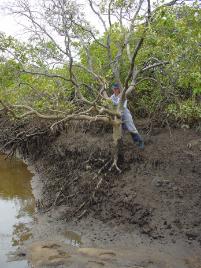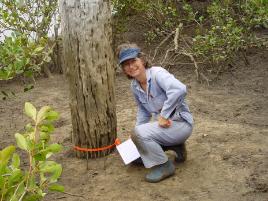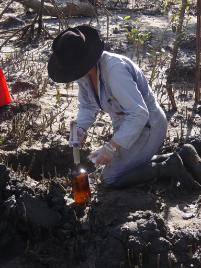No link found between herbicide levels and mangrove health, says Dr Wake
Published on 14 October, 2010
Mackay-based researcher Dr Judith Wake presented results of a four-year study into mangrove health in the Pioneer River estuary, during the International Challenges in Environmental Science and Engineering Conference held in Cairns recently...
The study* looked at the progress of mangrove dieback in the region and potential connection to herbicide run-off. LINK HERE for more Conference Details

Dr Judith Wake ... investigating herbicide levels and mangrove health
Using PAM fluorometry, a very sensitive measure for detecting the effects of commonly-used agricultural herbicides such as diuron on photosynthesis, the study found that there was no relationship between herbicide levels in mangrove sediment or corewater and the health of the mangroves.
This overturns the results from an earlier study that was based on much lower levels of herbicides and didn't utilise PAM fluorescence.
The study also found that the mangrove communities were recovering from the dieback, with significant recruitment of seedlings into previously affected areas.
Papers from the conference will be published in the Marine Pollution Bulletin.
Dr Wake's study used a stress index with indicators including estimates of canopy cover and tree canopy health, and the occurrence of dead branches, leaf yellowing, adventitious roots and epicormic growth. The index was compared among locations and years.
According to the publication abstract, mangrove sediment and core water samples were analysed for photosystem II inhibiting herbicides. Diuron was present in sediment samples from all locations in all years, with higher levels in the upper reaches of the estuary (maximum of 35 mgkg-1dw). Ametryn, atrazine and hexazinone were also commonly found and herbicides were also detected in many core water samples.

Dr Wake in the fieldDespite high levels of herbicides, there was no evidence of widespread dieback of Avicennia. Some sites showed high stress indices but stress was not correlated with herbicide levels in core water or sediment. Recruitment of seedlings was evident in some areas severely affected by past dieback.
In 2007, pulse amplitude modulated (PAM) fluorometry was used to assess the impact of the herbicides on photosystem II. There was no significant correlation between photosystem II activity and the levels of diuron in either sediment or core water. These findings are not consistent with mangrove health being affected by diuron.
There was no evidence from changes in substrate and pneumatophore height that sedimentation was adversely affecting the health of Avicennia marina.
* The project was funded by Reef Catchments Mackay Whitsunday Inc under Natural Heritage Trust funding.



